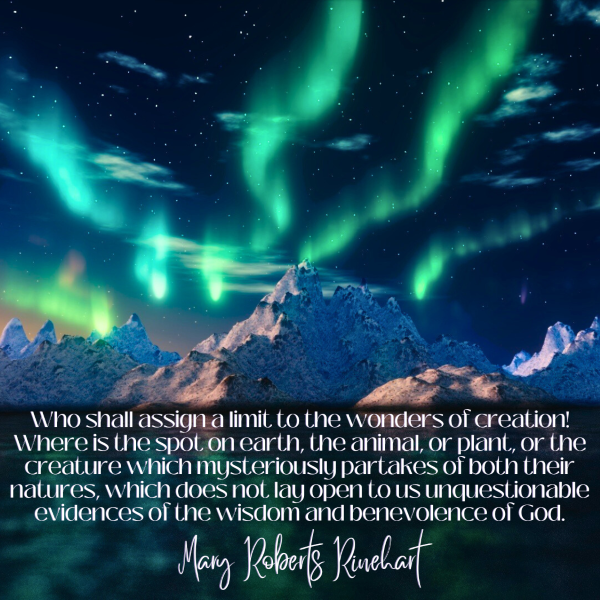Nature is a canvas upon which God has painted His masterpiece, with each brushstroke revealing His infinite creativity and attention to detail. From the microscopic to the macroscopic, this week we are celebrating the genius of our Maker and applauding His absolute perfect work.

Comprehensively Detailed
From the depths of the ocean to the heights of the mountains, every corner of the earth bears God’s imprint. Throughout the natural world, we find diversity and underpinnings that defy human comprehension. Covering all His bases, the infallible hardwired processes inherent to nature empower the sustainability of life. To truly appreciate the inner workings of nature's composition, below are examples of God’s awesome ingenuity.
The Biological Buffet
The core of nature's sophistication is the elaborate network of biological systems that support all life. Being one of Earth's most valuable assets, biodiversity has a vast range of impacts on ecosystems, humanity, and the planet as a whole.

Diverse Ecosystems: Whether the arid deserts, lush rainforests, enchanting coral reefs, sweeping savannas, or waterlogged wetlands, each ecosystem dazzles with vibrant colors, unique species, soft melodies, and ecological interactions that showcase God’s boundless imagination.
Medicinal Resources: As they are derived from natural resources, the ample diversity affords the development and access to various medicinal treatments.
Climate Regulation: Biodiversity facilitates climate regulation by absorbing carbon dioxide, releasing oxygen, and influencing weather patterns.
Food Security: Crucial for food security, the diverse agriculture provides a solid array of crops, livestock, and wild flora.
Aesthetic Value: While the radiant hues of wildflowers dancing within meadows set against the backdrop of rugged mountains contrast with the flourishing greens and towering canopies of ancient forests, they contribute to the wondrous palette of sights, sounds, and textures that let every landscape tell its story; enriching Earth with beauty and endless diversity.
Anatomical Rigor
One of the most striking examples of God's handiwork is found within ourselves. Every aspect of our physiology points to a Creator who has fashioned us with great care and precision.
Nervous System: Responsible for processing sensory information, coordinating bodily functions, and enabling conscious thought and voluntary movement through the use of billions of neurons and exceptional communicative networks, the central nervous system (CNS) connects the CSN to the rest of the body.
Immune System: Consisting of white blood cells like lymphocytes and macrophages, and organs like the lymph nodes, spleen, and thymus, the immune system is a practical defense network that protects the body from unhealthy pathogens.
Endocrine System: Overseer of the interactions between hormones and target organs, the endocrine system regulates bodily functions that allow the body to maintain homeostasis and respond to internal and external changes.
Cardiovascular System: Comparable to a bus for your blood, the circulatory route of the cardiovascular system transports oxygen, nutrients, hormones, and waste throughout the body; ensuring a balance of blood flow and pressure to sustain bodily functions.
Musculoskeletal System: Providing structure, support, movement, and protection over internal organs, the musculoskeletal system is comprised of highly complex coordinated processes. It governs the attuned movement between muscles and bones, the mechanical properties of joints, and the ability to repair and adapt to stress through processes like bone remodeling.
Analytically Attractive
Although appreciative of functional purposes and exquisite beauty, the inherent development of natural patterns continues to captivate scientists and observers alike, as the biosphere is filled with complex patterns that can only be explained through God’s innovativeness and mathematical accuracy.

Fibonacci Sequence: The widespread natural occurrence of the Fibonacci Sequence mystifies human comprehension. Found in the arrangement of leaves around stems, spiral patterns of seashells, the design of the seeds in a sunflower head, and much more, the Fibonacci sequence is a mathematical pattern where each number is the sum of the two preceding numbers (e.g., 1, 1, 2, 3, 5, 8, etc.).
Fractals: Witnessed in tree branches, coastlines, snowflakes, and clouds, Fractals are geometric shapes that can be divided into smaller parts, each of which is a miniature version of the whole.
Animal Migration Patterns: The obscure underlying structural basis for wildlife’s habitual migration patterns that drive animals to embark on strenuous journeys is baffling and largely not understood.
Spiral Galaxies: Still actively being researched, spiral galaxies emerge from the precise mechanisms and interactions of stars, gas, dust, dark matter, and other cosmic forces. Spiral galaxies are characterized by their hypnotic lumen and glimmering whirled pattern.
Synergistic Collaboration
The intimate and collective relationship between living organisms creates a delicate balance that bolsters the overall health and stability of their respective environment.
Interdependence in Coral Reefs: Thankful for protection and a stable home among the Coral Polyps, Zooplankton undergo photosynthesis and earn their keep by providing the coral with vital nutrients.
Cleaning Symbiosis in the Ocean: The dermatologists of the ocean, Cleaner fish secure a steady food source by forming symbiotic relationships with larger fish by removing parasites from the skin of the larger fish, which contributes to the larger fish’s overall health.
Fungus-Plant Partnerships in Forests: Attaching themselves to the roots of trees, Mycorrhizal Fungi help the trees absorb important nutrients from the soil. The trees return the favor by providing the fungi with sugars and other nutrients they obtain from photosynthesis.
Commensalism in the Savannah: Serving relief to Giraffes and other large herbivores, certain species of birds, like the Oxpecker, feed on ticks and other parasites congregating upon the Giraffe’s skin.
Customizable Integration
Nature is replete with examples of radical solutions to the challenges of survival. One of the most awe-inspiring aspects of organic life is the process of adaptation and evolution. Over millions of years, organisms have evolved specialized adaptations to thrive in diverse, and sometimes challenging environments.

Flora
Cacti's Water Storage and Defense Mechanisms: Able to survive dehydrated environments, the thick fleshy spine of cacti boasts specialized water-storing structures and is adorned with spines that reduce water loss through transpiration.
Venus Flytrap's Insect-Trapping Mechanism: Native to decaying and nutrient-poor bogs and swamplands in the Carolinas, remarkably, the Venus Flytrap has adapted to sense and respond to touch. Attempting to avoid starvation in the bleak and inhospitable living conditions, the leaves of Venus Flytraps’ have been tailored to ambush insects when triggered. When triggered, the flesh-eating leaves envelop the insect; sealing them to their fate.
Mangrove Trees' Salt Tolerance and Aerial Roots: In order to aid the process of gas exchange in moisturized environments, the roots of Mangrove Trees grow above the soil and prevent salt absorption from the sodium-chloride-rich air.
Resurrection Plants' Extreme Desiccation Tolerance: Famous for their ability to seemingly resurrect themselves from extreme dehydration, Resurrection Plants can lose up to 95% of their water content and still survive. When exposed to moisture, they "resurrect," reviving from a desiccated state to a flourishing zest.
Fauna
Arctic Fox's Chromogenic Fur: The fur of the Arctic fox undergoes a seasonal modification as an added security for its survival in the harsh Arctic climate. Changing from white to brown/grey, the Artic Fox is able to camouflage and blend in with the delicate snow sweeping the landscape, or against the vegetation of the rocky terrain.
Star-Nosed Mole's Tactile Sensitivity: Colossally visually impaired, the Star-Nosed Mole nose is covered with thousands of teeny receptors that allow the mole to successfully find food, identify prey, and navigate its habitat.
Platypus's Electroreception: Holding a spot as one of only three known mammals to have electroreception, the Platypus’s bill is equipped with electroreceptors that allow it to detect the electrical signals from muscle contractions of its prey.
Peregrine Falcon's High-Speed Flight: Together, the streamlined body, powerful muscles, and distinguished feathers qualify the Peregrine Falcon to be the fastest animal on Earth; reaching astonishing speeds that can exceed 240mph.
Chameleon's Polychromatic Skin: Renowned for their ability to change color, Chameleons can manipulate special pigment-bearing cells called chromatophores. This allows them to blend into their environment and communicate aggression, mating readiness, or stress.
Oh, What a Wonderful World

Whether we peer through a microscope or gaze up at the night sky, we are met with beauty that leaves us in awe of the One who ushered it all into being. Every bit of Earth depicts His flawless artistry. Truly, the heavens declare the glory of God, and the skies proclaim the work of His hands (Psalm 19:1). Over this next week, we challenge you to awaken your inner Louis Armstrong - take notice of the natural world, and consider the beauty and the significance of God’s skill and talent.
-Torrance Church of Christ












